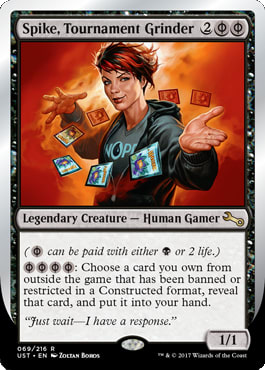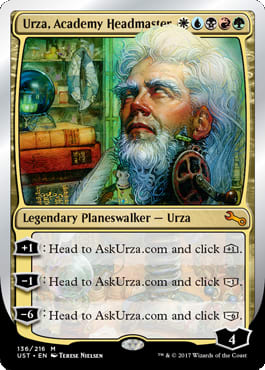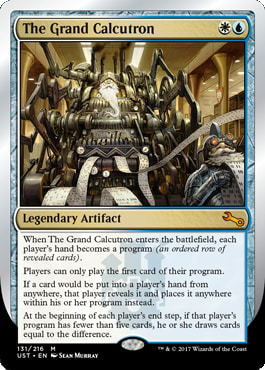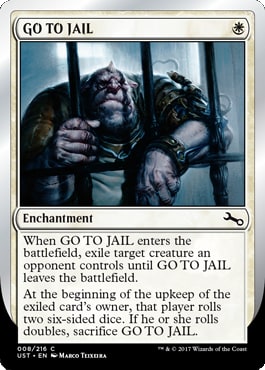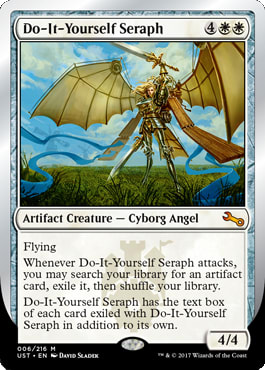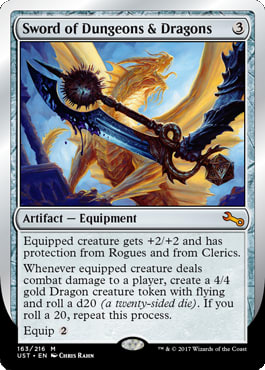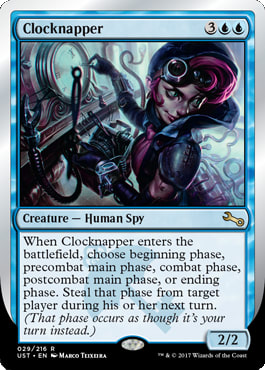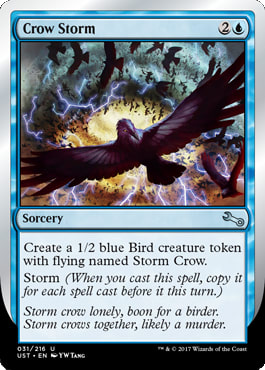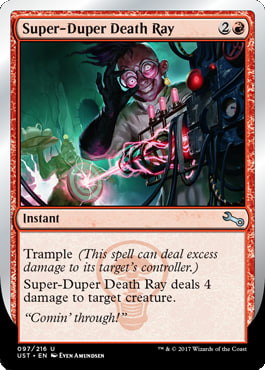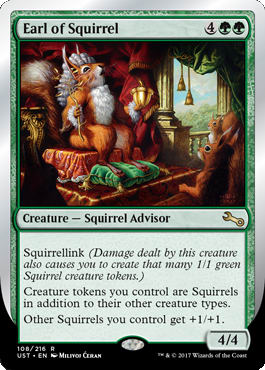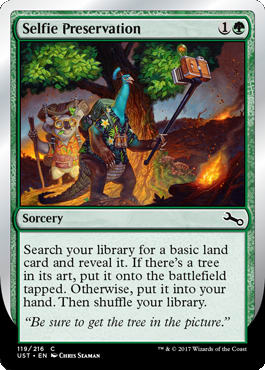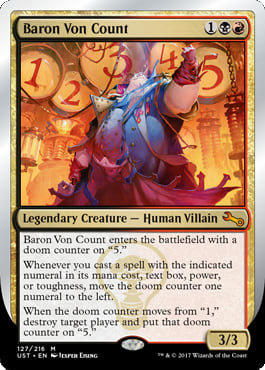Of note: Know that these evaluations are based on actual play in my Cube and not merely outsourced to speculation or limited play. If I'm saying a card has been working well based on my experience, it's based on actual experience from trying them out in my Cube and finding the cards have been working well/poorly in my Cube.
Although Cube originated in Toronto in 2001, 2004's Unhinged wasn't designed with Cube in mind, as the format was still under the radar of most M:TG players, let alone R&D. But as Mark Rosewater noted on his blog, the set was designed with Cube in mind, since cards from un-sets are used in Cubes, even if they are in much lower rates than non-silver bordered cards, as even the CubeTutor 720-average Cube doesn't have a silver-bordered card as the time of this article.
Despite the Cube format taking more of a serious approach, Cube's origins were very casual and occupied similar interest space with Type 4. The original Cubes, created in Ontario in 2001, had Rukh Egg and Su-Chi erratad, having their death triggers happen if they went to the graveyard from anywhere to make them more powerful. I talked with Gary Wise, one of the drafters of the original Ontario Cubes, about the origins of Cube, and he noted how Cube's initial ethos was much like how many people view Cube -- as a way to do the most broken things with the best cards of all time in a casual setting. Most non-MTGO Cube games are still unsanctioned and are played with the ethos of doing broken things, and Unstable allows Cube designers to touch on the mentality of doing the most broken things, by allowing the inclusion of cards that have some elasticity in where the rules lie and while Mark Rosewater's FA-WallOfText-Q talks about some cards, there's some leeway which I'll talk about when talking about individual cards.
That being said, I've found that if you include these kinds of changes to Cube, whether you're errata-ing all of your lands to be snow-covered lands, allowing Wastes to be in the basic land pile or other "house rules," it's best to be upfront about these kinds of things, especially if you don't have a consistent Cube group, because even though, in theory, drafters can ask questions like "Why is Skred in this Cube?" or "Can I only use things like Strip Mine or Sol Ring for my Thought-Knot Seer?", people generally choose to not bother asking those questions. This results in them taking something else and passing the card along and end up having the experience being negatively impacted by feeling that they were the victim of a "gotcha" effect.
Although cards from the un-sets work in the vein of Cube's origins, many Cube designers have chosen to not use cards from the un-sets. I asked online and found various reasons, from them feeling gimmicky/not like real M:TG cards, to them causing awkward constraints in drafting/interaction (gotcha cards/Cheatyface.)
Like many things in your Cube, the choice to include or not include un-cards is your decision as a Cube designer, but even still, there's some nuance in where you can choose where the line in the sand lies.
Predictably, I'll first cover Spike, Tournament Grinder. Using sanctioned rules for Limited, cards that reference getting cards outside of the game can only get cards from the sideboard. Playing the card closer to its intent of getting anything makes it so that options are the following:
- Play it where you can only get cards from your SB, per sanctioned Limited rules.
- Play it to where you can get anything from the undrafted portion of the Cube.
- Play it to where you can just get anything.
Playing with mode A, I found that it was very inefficient. My Cube runs power and, to sound cliched, the decks that had power wanted them in their deck, not in the sideboard and, although Phyrexian mana could be used, the cost of using it added up quickly. It had some niche applications where it could get things from the sideboard that couldn't make the maindeck (getting Cranial Plating to win once) but all in all, it was too inefficient to be worth it.
Mode B ends up having issues anyone who's played Booster Tutor can attest for -- it's a powerful card, but can result in logistical annoyances where, if playing in a spread out location, means having to move the Cube around or making sure it's close to the person with the card, and can take a while for someone to leaf through the entire undrafted Cube, moreso with Spike since she can be used multiple times.
Mode C ends up being ridiculous as it can get both parts of the vault key combo but it turns out that there are a lot more cards that it can tutor for, from Bazaar of Baghdad to Juggernaut to Kird Ape.
These modes will dictate how good the card is in your Cube, but as noted, please be upfront with what one you'll use, as it's incorrect to just assume drafters will know.
Urza, Academy Headmaster -- falls under the same pitfalls as other 5-color cards, in that only one deck really wants it, so you'll want to be very sure that you want a card to be used for that specific purpose (even if it's just for funzies, yolo.) Unfortunately, due to the randomness of its abilities (taken from all previous planeswalkers), it's just incredibly inconsistent and not worth the narrowness in playability or its inconsistent impact when it resolves; and, in the case of some abilities, like Ob Nixilis of the Black Oath's -2 ability, it can backfire on you.
The Grand Calcutron is a unique card that follows similar trends to Geist of Saint Traft and Spell Queller in that it works best in decks other than ![]()
![]() control. The gap is much wider with The Grand Calcutron. Whereas cards like Geist of Saint Traft can be played as a wincon in
control. The gap is much wider with The Grand Calcutron. Whereas cards like Geist of Saint Traft can be played as a wincon in ![]()
![]() control, The Grand Calcutron is terrible in that deck. It hoses reactive decks very hard since it forces sequencing and making countering spells incredibly difficult. Because of this, it falls into a weird space where it's not as good in the decks that naturally want to play it, but it's absurd in decks that want it, like more beatdown friendly Azorius tempo decks or decks like White Weenie splashing Blue for some card advantage spells and this. This may make it a rough sell for a traditional
control, The Grand Calcutron is terrible in that deck. It hoses reactive decks very hard since it forces sequencing and making countering spells incredibly difficult. Because of this, it falls into a weird space where it's not as good in the decks that naturally want to play it, but it's absurd in decks that want it, like more beatdown friendly Azorius tempo decks or decks like White Weenie splashing Blue for some card advantage spells and this. This may make it a rough sell for a traditional ![]()
![]() section, but if you want to shake things up or give some spice to
section, but if you want to shake things up or give some spice to ![]()
![]() decks, try this.
decks, try this.
GO TO JAIL is one of the cheapest "new" removal spells to be seen for some time. Since it's not a reliable straight-up removal spell, it's been best used as more a tempo play than a true removal spell, as there's a 1/6 chance it'll die. Therefore, adjust your expectations accordingly and think of it more like a temporary removal effect like Oust and Unexpectedly Absent than something like Journey to Nowhere. I've found myself pleasantly surprised at how well it can get something out the way (if only for a short period of time) to win the game as it almost never dies on the first upkeep and usually at least keeps something away for enough time. It wasn't uncommon for it to be used as a way to get something out of the way to make way for a game-winning alpha strike. The feelbads of hitting something with an enter-the-battlefield trigger and to have the creature come back is annoying, but overall, the tempo that it provides is great and I've found it to be a quality Cube card thus far (and unsurprisingly, it's absurd in non-rare Cubes, especially in Pauper where the quality of creatures with enter-the-battlefield triggers drops.)
Do-It-Yourself Seraph -- is clunky since there aren't many passive artifacts that you'd want to get, but there are some which get a boost with her (Winter Orb, Smokestack, Walking Ballista.) However, 6 mana for something that "fails the Vindicate test" is usually a death knell for Cube and this doesn't really do enough to make up for it, even in instances where it can survive until your upkeep.
Rules Lawyer does a LOT. A small Platinum Angel at worst and a whole lot more at best. It's fragile and its body is terrible, but I found that if the opponent doesn't just have the removal spell for it, it can take over the game, even in subtle ways like letting a Planeswalker stay alive with 0 loyalty.
Sword of Dungeons & Dragons is one of the worst swords for Cube, but as that's a high bar, that's ok. It's mainly a "build your own saboteur", although it's slow and its protections are nearly useless. Despite being slow and having nearly useless protections, I found that it creating a 4/4 flier makes it so that it creates a scenario where the opponent is very heavily incentivized to block it or lose quickly
Clocknapper is another type of card like Fatespinner. The "beginning phase" is the real winner, and having it act as a Mulldrifter with an additional untap phase/stopping an opponent from untapping and then drawing is the best out of them:
During that player's next turn, as the chosen phase begins, you treat it as if it were your turn. Let's walk through what happens if you steal each phase:
Beginning phase -- You untap permanents you control and your opponent doesn't. Abilities that trigger at the beginning of your upkeep happen and ones that trigger at the beginning of their upkeep don't. You draw a card as it's now your draw step, so your opponent doesn't.
Precombat main phase -- You can cast all types of spells while your opponent can only cast instants and spells with flash.
Combat phase -- Just like combat on your turn, you can attack your opponents with your creatures. The opponent you stole the phase from can't attack with their creatures, but they can block.
Postcombat main phase -- Same as precombat main phase.
Ending phase -- Most abilities that trigger during the end step don't care whose turn it is, but keep an eye out for anything that does. Effects that last "until end of turn" or "this turn" will expire as normal, as they also don't care whose turn it is.
There's some utility with the other modes, but I found it never really mattered since stealing an opponent's untap and draw step was head and shoulders above the other modes (and even stealing upkeep was nice with cards like Ancestral Vision, but was more the exception than the rule) -- but, it's always nice to have some extra options. Arcane Savant was another great Blue 5-drop, and this joins it for those who want another "wacky" 5-drop. As blasphemous as it is to say, Clocknapper may just be the best 5-drop in Blue, Arcane Savant (in most scenarios -- unless it hits something absurd like Cruel Ultimatum, Seasons Past, Upheaval, Wildfire/Burning of Xinye or Tooth and Nail) aside.
Crow Storm is yet another storm card. Generally, if you're supporting storm, more good cards with the keyword are welcome, although, this doesn't provide the "deal with this or die" as much as Empty the Warrens, it's a nice card to supplement storm strategies, so if you're playing that strategy in your Cube, you should likely look to add this card rather than phone it in and only consider swapping.
Extremely Slow Zombie has a drawback with last strike, but I found that it usually isn't that bad if you have decent board control. It can get outclassed by "wall of creatures" boards. Then again, attacking with a 3/3 into a wall of 2/2s isn't a good idea anyway, since it just results in the opponent losing a 2/2 and there aren't a lot of 3/3s in the format for it to lose out on trades. Like with GO TO JAIL, it's a solidly efficient creature with a drawback that's easy to overstate (and is also great in non-rare formats) and a nice Black aggressive creature for Cubes that support that strategy.
Super-Duper Death Ray is a card that could realistically be printed, Soulfire Grand Master being a great precedent for spells having creature abilities. It's similar to cards like Searing Blaze, a card that deals with things and hits the opponent as well (usually.) I've talked about how cards like Searing Blaze and Smash to Smithereens work well in aggressive decks as they push forward momentum while getting rid of something annoying and still pursuing the aggro Red game plan -- dealing damage to the opponent. This is another one of those with a few knobs twisted (it can hit bigger creatures ) but it kills almost everything in Cube and not as much "damage wasted" when hitting small things. Because of this, it's been very good at being a removal spell for aggressive Red decks and I found it usually acts like Lunge that can also deal with other annoying things like Wall of Omens/Wall of Blossoms and other things. All in all, a solidly efficient Red card.
Earl of Squirrel is a pretty good creature that does suffer a similar fate as Do-It-Yourself Seraph, both being six-mana creatures that fail the Vindicate test, but the earl has a much higher ceiling as it's absurd if it untaps and deals damage. However, I found that it still was just vulnerable and didn't cut the mustard. Animate Library worked similarly, although it can least one-shot people. Infinity Elemental and Three-Headed Goblin suffered similar fates.
Hangman is a card that looks better than you'd think. It plays a similar role to level up cards as a creature that starts off small and then just balloons to an incredibly large size, usually to the point to where it's a virtual The Abyss. I've found it's not uncommon for it to be a 5/5 or larger, especially if it's a difficult-to-guess word being named, but even with the case of easier-to-guess words, Hangman doesn't tend to be smaller than a 2/2 for long.
Much like Heirloom Blade, being prepared in advance is very useful for getting maximum use of the card and having some difficult words to guess can really help to make it better, but not having a 8-character word with no repeating characters doesn't make this perform badly.
Masterful Ninja is a free shade that dodges wraths/sorcery speed removal and helps with some of the issue with aggressive creatures being outclassed in the late game. It's cliché to say "it's good if you include Black aggro" but the adage applies for good reason -- Firedrinker Satyr is garbage in decks other than Red aggro. It's arguable that if Black aggro decks weren't well supported in your Cube, that it can be with the best leveler and the best Memnite/shade of all time -- or that the archetype gets that much better, as both cards have already been part of 3-0 performing aggro decks in my Cube, but ultimately that decision lies with you. While these cards can, in theory, be played as low-cost threats in non-aggro decks, I've not seen it used in those theaters, so adjust your expectations accordingly.
Summon the Pack -- many people who've tried Booster Tutor make it so that "a sealed pack" is 15 random cards from the undrafted portion of the Cube. One of the things that got old fast was having to get the Cube, sometimes from the other side of the table, or needing to make sure that it's close by, especially if recurred. Being a high-cost spell does limit how often it's cast but it still asks the question -- for a high-cost spell to be good in Cube, it had better have extremely high value and had better end the game (or be close to it.)
Frank Karsten's article talked about its expected value with retail packs and here's a Sample pack generator if you're too cheap to crack a pack, but if we're playing it in the way I talked about earlier, here are some sample "packs" from Cube:
From my current Cube iteration:
Pack 1:
- Thran Dynamo
- Elesh Norn, Grand Cenobite
- Force of Will
- Ophiomancer
- Lore Seeker
- Consecrated Sphinx
- Swords to Plowshares
- Sword of Light and Shadow
- Day of Judgment
- Pia Nalaar
- Phyrexian Metamorph
- Snuff Out
- Mana Crypt
- Bloodstained Mire
- Gravecrawler
Pack 2:
- Kari Zev, Skyship Raider
- Figure of Destiny
- Ajani Goldmane
- Selesnya Signet
- Strip Mine
- Ineffable Blessing
- Gemstone Mine
- Tropical Island
- Baneslayer Angel
- Boros Signet
- Umezawa's Jitte
- Toxic Deluge
- Blade Splicer
- Deceiver Exarch
From the CubeTutor 450-card average:
- Thraben Inspector
- Yavimaya Elder
- Grave Titan
- Consecrated Sphinx
- Simic Signet
- Bloodsoaked Champion
- Thalia, Guardian of Thraben
- Badlands
- Rancor
- Taiga
- Sakura-Tribe Elder
- Wooded Foothills
- Breeding Pool
- Ophiomancer
Are these good enough to end the game? Some packs, like the 2nd pack are somewhat underwhelming even if they are technically more mana combined than what you put into it.
Unlike colors like Green and Blue, there aren't a lot of "go big" spells in Black and this serves as a really good finisher to close the game out. If you don't mind the logistical annoyances, it's worth playing.
The Countdown is at One - ![]()
![]()
![]() is a lot, but essentially doubles the clock if your deck can do it which isn't a problem in Red aggro decks, especially those with some cheap burn. Logistical annoyances are a real factor, especially if playing in an area where space is a real constraint, and it's poor as a curve topper in the traditional sense in that it doesn't end the game on its own, but it generally closes out the game soon after being cast.
is a lot, but essentially doubles the clock if your deck can do it which isn't a problem in Red aggro decks, especially those with some cheap burn. Logistical annoyances are a real factor, especially if playing in an area where space is a real constraint, and it's poor as a curve topper in the traditional sense in that it doesn't end the game on its own, but it generally closes out the game soon after being cast.
Selfie Preservation is a worse Rampant Growth and a pretty poor card overall.
Five-Finger Discount is an interesting riff on bounce / Gonti-style abilities, but it's very mana intensive and gimmick aside, it's a bad Confiscate.
Baron Von Count has a decent on-curve body, but it's pretty tough to sequence your plays so that you can make it kill someone. Multicolored competition is rough, and it's going to be tough to justify this when it's competing with much better Rakdos things.
Cards that reference other players or people, like Squirrel Dealer, get some value in team drafts; and, if you regularly team draft, these kinds of cards are going to be great in your format.
Lastly, I'll cover some of the set's Variable mode cards although these cards generally have one mode that's just better than the others.
Knight of the Kitchen Sink's pro black border variant plays somewhat like True-Name Nemesis although obviously not as strong as it can't be equipped, but that doesn't mean it loses much and is still a top-tier 2-drop in White. There's some rules elasticity where you can make it so tokens can/can't block it and you can tweak some removal that can hit it (Lightning Bolt, Incinerate, Disenchant, Naturalize, Terror -- if you want to run that, Psionic Blast.) However, even aside from that, it's still similar to cards like True-Name Nemesis where it's very hard to interact with and usually it just dies to wraths or a few cards, depending on your Cube's individual cards. It being a 2/2 wall that only dies to a few things and Wraths makes it a top-tier White card. The other variants of Knight of the Kitchen Sink are pretty weak for Cube.
Very Cryptic Command has cubable mode: the Boomerang/Catalog/Redirect/turn into a 2/2 mode.
Much like Kolaghan's Command, the sum of the parts looks a lot better than the individual parts and I found that Boomerang/Catalog is one of the better modes of the spell, but the non-redirect modes all have had uses thus far from trying it out. The Redirect mode is a nice niche mode that, like Boros Charm's double strike mode, doesn't get used much but it's a nice option for when opportunities arise.
Since there aren't many cubeworthy cards with XXX mana costs, this can lead to some unfair comparisons to Cryptic Command, since it shares a name with Cryptic Command and, much like how Elspeth, Sun's Champion was initially maligned by many due to comparisons to other 6-mana Planeswalkers at the time like Garruk, Caller of Beasts and Sorin Markov (since there aren't many of them). It feels like it's been underrated similarly as a card with a lot of in-game play but has hard competition.
Ineffable Blessing -- only really has one good version, the one that triggers on "flavorful/nonflavorful" modes. This makes it so that it acts almost like a Glimpse of Nature which, unsurprisingly, is great with tokens. I've found that in most decks, it generally helps about half of the deck for decks that play it as a general value card, which is still great value for only![]()
![]() . All in all, I've been a fan of it.
. All in all, I've been a fan of it.
Garbage Elemental has a mode for being a ![]()
![]() 3/3 cascade is the best mode as a store brand Bloodbraid Elf or a card similar to Keldon Champion, but also has a hard time competing with most five-mana Red creatures (and we even got a 5/5 hasty trampler for
3/3 cascade is the best mode as a store brand Bloodbraid Elf or a card similar to Keldon Champion, but also has a hard time competing with most five-mana Red creatures (and we even got a 5/5 hasty trampler for ![]()
![]() in Ixalan).
in Ixalan).
My blog, featuring my Pauper and powered Cube lists.
Cube podcast, The Third Power, that Anthony Avitollo and I host.
Find me on Twitter @UsmanTheRadUsmanTheRad













